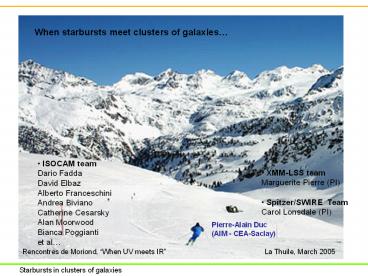Prsentation PowerPoint - PowerPoint PPT Presentation
Title:
Prsentation PowerPoint
Description:
Location of the emission-line galaxies in the merging cluster Abell 3921 ... a field effect (general evolution of galaxies falling in the cluster) ... – PowerPoint PPT presentation
Number of Views:37
Avg rating:3.0/5.0
Title: Prsentation PowerPoint
1
When starbursts meet clusters of galaxies
- ISOCAM team
- Dario Fadda
- David Elbaz
- Alberto Franceschini
- Andrea Biviano
- Catherine Cesarsky
- Alan Moorwood
- Bianca Poggianti
- et al
- XMM-LSS team
- Marguerite Pierre (PI)
- Spitzer/SWIRE Team
- Carol Lonsdale (PI)
Pierre-Alain Duc (AIM - CEA-Saclay)
La Thuile, March 2005
Rencontres de Moriond, When UV meets IR
2
When starbursts meet clusters of galaxies
- ISOCAM team
- Dario Fadda
- David Elbaz
- Alberto Franceschini
- Andrea Biviano
- Catherine Cesarsky
- Alan Moorwood
- Bianca Poggianti
- et al
- XMM-LSS team
- Marguerite Pierre (PI)
- Spitzer/SWIRE Team
- Carol Lonsdale (PI)
Pierre-Alain Duc (AIM - CEA-Saclay)
La Thuile, March 2005
Rencontres de Moriond, When UV meets IR
3
(A lack of) activity in clusters of galaxies
- Clusters of galaxies an a priori hostile
environment for the galaxy activity
(star-formation, AGN) - Infalling galaxies suffer
- Ram pressure gt ISM lost
- Strangulation gt External Gas reservoir lost)
- Harassment gt Disk destroyed stars lost
Ram pressure stripping of the galaxy ISM by the
ICM
- Indeed, locally, the star formation activity is
reduced in denser environments such as clusters - -gt HI deficiency
- -gt SDSS results a decline of the mean SFR as a
function of local surface density
Courtesy of B. Moore
Harassment
4
(Some) activity in (nearby) clusters of galaxies
Outskirts of clusters
Merging clusters
Ferrari et al., 2005
Location of the emission-line galaxies in the
merging cluster Abell 3921
Virgo cluster of galaxies HI contours on X-ray
map
5
(Much more) activity in (distant) clusters of
galaxies
- The Butcher-Oemler effect
- As a function of redshift
- Increase in the fraction of blue galaxies
(Photometric BO) - Increase in the fraction of spirals
(Morphological BO) - Increase in the fraction of star-forming
galaxies and post starbursts (Spectroscopic BO) - An environmental effect (role of the cluster
dynamics, ICM) or - a field effect (general evolution of galaxies
falling in the cluster) ?
(A high level of) activity ? How
obscured? Clustering of distant mid-IR sources?
6
The infrared view of the activity in clusters
- IRAS (20 years ago)
- ISO (10 years ago)
- Spitzer (present)
- The first infrared maps of a few intermediate-z
clusters evidence for a significant dust
enshrouded activity LIRGs in clusters - See review by Metcalfe et al. (2005), Space
Science Review ISO special issue
- Wide surveys statistics on the amount of star
formation in clusters of galaxies and their
surrounding
- Faint infrared fluxes of galaxies located in the
most nearby clusters (Virgo) - no LIRGs/ULIRGs
7
- Abell 1689
- at z0.18
HST/ACS
8
Star-forming activity in Abell 1689
Duc et al. 2000
9
Star-forming activity in Abell 1689
Duc et al. 2000
- A population of dust enshrouded SF galaxies?
10
- ISOCAM 15 mm observations of J1888.16 CL
(z0.56) - - discovered on deep optical AAT plates detected
in the X-rays by ROSAT (Lx1.7 1044 erg/s) shows
an excess of blue galaxies (BO effect) - A strip of 3 x 15 arcmin
- (1.3 x 5.9 Mpc) in the LW3 band covering the
outskirts of the cluster - - Ground-based follow-up
- at ESO (WFI, SOFI, VLT)
- 44 MIR sources detected
- (redshift measured for 27 of them)
Duc et al., 2004
11
- ISOCAM 15 mm observations
- of J1888.16 CL (z0.56)
- 8 15 mm sources
- associated with spectroscopically confirmed
cluster members
12
Star Formation Rate (Mo/yr)
Ellipticals at z0.6
Scd,irr at z0.6
Cluster members
Background/foreground
Infrared Luminosity (Lo)
- A population of Luminous Infrared Galaxies in
J1888.16CL
13
Spectroscopic properties of the LIRGs in
J1888.16CL
- Optical signature of dust enshrouded starburst,
typical of luminous infrared starbursts
Histogram of optical spectral type
(Poggianti et al., 2001)
14
- Where, when and how the cluster IR activity was
triggered ? - In the surrounding field ? are the MIR sources
recently accreted field LIRGS? - 8 in 100 Myr (typical duration of LIR phase)
- -gt too many given the percentage of field LIRGs
- Within the cluster itself ?
- Velocity dispersion of MIR sources
- 700520-260 km/s
- Possible mechanism an initial shock-induced
burst before the gas is stripped by ram pressure ?
- Within sub-groups, accreted along filaments ?
- Possible mechanisms
- Tidal interactions if the velocity dispersion
is low enough - Effect of the global tidal field on infalling
groups (Bekki, 1999) - or during cluster-cluster merger (Miller, 2003)
15
(Much more) activity in (distant) clusters of
galaxies
Coia et al., 2004
ISOCAM 15micron map of CL00241654 (z0.39)
16
- Conclusions (ISO based)
- From mid-infrared ISOCAM data
- Evidence for a dust enshrouded activity in
nearby cluster of galaxies (Abell 1689, z0.18) - Discovery of even more active Luminous Infrared
Galaxies in intermediate redshift clusters (i.e.
J1888.16CL, z0.56) - Optical signature of dust enshrouded starbursts
- Most active regions in the cluster outerskirts
- The triggering mechanism is still unclear tidal
collisions in falling sub-structures, cluster
mergers ? - An IR BO effect needs to be quantified the role
of Spitzer
17
When X-ray meets IR
- XMM -LSS 10ks X-ray map with XMM-Newton of a
large contiguous area (5 sq deg sofar) - A sample of X-ray selected groups and clusters
- SWIRE IRAC and MIPS maps
- of 9 sq degree.
- Observed Aug 2004
- .
- CFHTLS optical ugriz Megacam images at CFHT
- VVDS optical VLT/VIMOS spectra
- TISWAZ optical 2dF spectra
18
XMM-Newton true color map of D1 field
19
XMM-Newton true color map of D1 field
20
XMM-Newton true color map of D1 field































